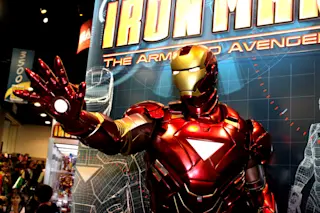Smashing through walls, flying through the air like a human jet, controlling an amazingly complicated robotic suit of armor effortlessly, seemingly by mere thought. Oh, and being practically indestructible.
This is the Marvel Comics character Iron Man. The full title of the comic is actually The Invincible Iron Man, a kind of giveaway about the powers he is supposed to possess. Being invincible is a pretty tall order. Basically Iron Man is a really, really smart guy—ok, he is a genius—in a super high-tech suit of armor.
The origin story for Iron Man, like that of all comic characters, has been revised, revisited, and re-created over the years, but the essential idea is that Tony Stark the industrialist gets kidnapped by bad guys. They know (as does the whole world because Tony Stark really is a genius and brilliant inventor and head of a huge international conglomerate) that he can build all kinds of devices. At this juncture, he moves away from being a capitalist solely concerned with profits from making munitions to becoming Iron Man, the iron-garbed superhero and founding member of the Avengers.
Iron Man belongs to that small club of superheroes who are viewed as possible. This is a key part of his appeal. It seems as if you could just pull on his suit and go flashing around. And you wouldn’t be entirely wrong: Although we cannot yet power up to use repulsor rays, some of Iron Man’s character is based on a realistic extension of concepts in neuroscience, robotics, biomedical engineering, and kinesiology that we already have today.
Dozens and dozens of armors have been used since the character’s debut in 1963, but let’s say for now that the Extremis armor, from the 2005–2006 Invincible Iron Man story arc, comes closest to what would work with a real human body inside. In this story, the Extremis procedure creates a kind of amplified neural network that allows Tony to interface with his armor and to jack in directly to control satellites and remote computers. This armor is a more advanced version than what’s seen in the Iron Man movies, as it is no longer merely clothing but part of the body. With Extremis, Tony Stark has the neural interface for his armor with him at all times as a layer of electronics just under his skin. Tony and the Iron Man armor are biologically integrated. He is in fact a cyborg.
Thoughts Into Action
How much of this concept is realizable? And what would the experience be like for the human inside (or part of) the Iron Man suit of armor?
Answering these questions brings us to the fascinating field of neuroprosthetics, devices that are used by or implanted into a person to improve sensory and, in some cases, cognitive abilities. They include retinal and cochlear implants to augment sight and hearing, spinal implants to relieve pain, among other things, and implants to assist with bladder control. Others are being developed to control robot limbs to move an object by simply thinking about it. These inventions, now in their infancy, are expected to help paraplegics, quadriplegics, and others with severely limited movement.
Most neuroprosthetics detect signals from the person’s nervous system and relay them to an electrical controller inside the device. The biological signals could be nerve signals or the electrical activity of muscles, detected by electrodes on the skin or implanted in muscle. In this way, the controller of the neuroprosthetic is literally connected to the neuromuscular system. Commands from the person can be relayed to the device to make it do whatever it is supposed to do to replace the lost function.
How can a brain interface control a machine? The first step is getting information from brain activity. One option is electroencephalography (EEG). The activity of neurons generates electric field potentials that can be measured with electrodes on the scalp. Brain activity changes depending on what you are doing, and although it gets a bit complicated, this EEG signal can be filtered, analyzed, and used as a control signal for computers and robotic devices, creating a brain-computer interface (BCI) or brain-machine interface (BMI).
In clinical neuroscience, tapping into brain commands for movement has been used to try to help people with certain neurological diseases. The terrible disease amyotrophic lateral sclerosis, or ALS, is one example. In ALS the lower motor neurons in the spinal cord, which control motion, all progressively die. During this process, the person becomes steadily weaker, is eventually paralyzed, and survives only until the motor neurons controlling the muscles for breathing also die.
In an attempt to help moderate the effects of the disease, scientists and clinicians can train people who are early into their ALS to use EEG signals to control a computer cursor. Making a simple device such as this available to many has been the passion of physician and neuroscientist Jon Wolpaw. Since the early 1990s, Wolpaw and his team at the Wadsworth Center of the New York State Department of Health in Albany have been working on a brain-machine interface system based on EEG activity recorded from the scalp, via a simple stretch cap outfitted with electrodes.
Recently this group has developed a BMI that can be taken into the home. The interface registers brain activity while the person observes a computer display that corresponds to a standard PC keyboard. With the BMI, the person uses brain activity alone to move a cursor on the screen, selecting letters to spell words. Currently some people with ALS who are approaching complete paralysis are using the Wadsworth device.
There are some great similarities between the Iron Man system and a basic brain-machine interface. Both involve extracting information about movement from brain activity, which is then processed into a command to control a device. By far the most complex BMI to date allows monkeys to feed themselves oranges using a robotic arm controlled by brain activity. Human studies have not reached this level of sophistication. We are a good way off from being able to remotely control a robotic suit of armor with brain-derived signals.
Allergic to Armor?
Jon Wolpaw points out something that I think is central to integrating a machine as intricate as the Iron Man armor with the complexities of the human brain and nervous system. That issue is not just of reaching some level of control but of achieving consistent control. According to Wolpaw, all the methods, both invasive (with electrodes positioned inside the brain) or noninvasive (with electrodes on the scalp) have the same problem: a disconcerting unreliability. “Control can be really good one day—or one three-minute period or even one trial—and really bad the next,” he says. “The proper conception of BCI use is not as mind reading but rather as skill development.” It’s like any other skill, except that it’s developed purely through brain activity. “The problem is that this skill doesn’t become as consistent as muscle-based skills typically do,” Wolpaw adds. “The fundamental reason for this is probably that BCI use is profoundly abnormal. The central nervous system evolved and is shaped throughout life to control muscles, period. A BCI asks it to control instead the signals from particular cortical areas, a major reorientation.”
Another challenge is the complexity of the Iron Man suit. To date, all BMI studies have used very simple tasks, and participants have focused on a single task at a time. This is “pretty artificial, since we rarely focus so much attention on simple motor tasks,” says Doug Weber of the University of Pittsburgh School of Physical Medicine and Rehabilitation, another leading scientist in the field. “No one has really studied how BMI performance changes when the user is performing other tasks in parallel. Multitasking would require at least a portion of the BMI control to be performed subconsciously.”
The bottom line is that, upon first jacking in to an Iron Man suit, any user would probably be able to learn how to do something straightforward like opening or closing one hand fairly quickly, within a few hours. How long to do something more complex like standing up and walking? Using benchmarks from neural rehabilitation after spinal cord injury or stroke, it is reasonable to estimate that about three months of training might provide the ability to stand up slowly and walk at about one-half the normal pace across a space of about 30 feet. That is pretty sobering when we think of what is shown in the comic books and movies. Grabbing the suit, throwing it on, plugging it in, and running off would just not be possible.
Another consideration is the integrity of the nervous system/electrode connection. It is very difficult to interface technology with biology. Based on state-of-the-art animal experiments, it seems only about 50 percent of implanted electrodes can be usefully employed. Of those, there is a significant reduction in usefulness over time, largely due to a process known as encapsulation or reactive gliosis, a type of scarring of the nervous system associated with immune rejection.
Jennie Leach, of the University of Maryland, and colleagues describe the body’s reaction to an implanted neuroprosthetic as beginning with a rapid acute response characterized by inflammation and what is known as microglial activation. Microglia provide the protective immune response cells in the brain and spinal cord. They are a kind of macrophage, which means they attack and digest invaders and foreign objects in the nervous system and are the first and main form of active immune response in the brain and spinal cord. If an intruder cannot be digested, the microglia cover it up so that it can do no harm. This response becomes chronic, which results in the formation of a virtually impenetrable glial or fibrotic scar around the implant.
There is a long way to go to get to a stable, enduring implant like that needed for a full brain-machine interface in an Iron Man suit. And then, on top of that, to have the brain subjected to the kind of continual head trauma that Tony experiences—being slammed into cars, pummeled by Iron Monger, slammed into a bus, and hit by bomb blasts—isn’t really a recipe for long-term success.
A Lifetime in Iron
ultimately, for an iron man suit of armor to be useful, it must be based on the kind of brain-machine interface hinted at in the Extremis story line. It must respond without having to be consciously commanded. This would free up neurological resources needed for more challenging tasks and environments. The user must also be highly trained and in tip-top shape.
Iron Man project development would require substantial improvements from where we are today. The technology to develop a system with articulated armor currently exists. Tony Stark or anyone else who wants to follow in his footsteps would need about two years to adapt such technology to create the full body armor that we see in Iron Man. An additional four years would most likely be required to strengthen and lighten the suit and then incorporate it all into a fully mobile passive system. Such a system would move like armor reminiscent of that of medieval knights but much more freely.
Next, providing the extras that Iron Man needs for his life of crime fighting would require motorizing and energizing the armor. A prototype would take another four years. Even when this improved armor was complete, its user would encounter a major problem: The current standard for this kind of approach in industry is to use hydraulic actuators (think of a forklift), which are extremely heavy. So Tony would have to make the armor even lighter and the motors much smaller and more efficient. A key focus for Tony in the next 10 years of developing his suit would be to miniaturize the motors that control the movement of the fully powered armor.
The next steps would each involve a slightly more invasive integration between the suit and the nervous system. The first would be to get stable motor control by using Tony’s own nerve signals to trigger the movement of the suit. Existing neuroprosthetics aren’t adequate. To bring it up to Iron Man capabilities would require improved processing of nerve signals, which would take about three or four years.
Then Tony would have to get around the delays and control problems that go along with using measurement of muscle activity. Tony would instead use direct brain commands to move the suit, requiring a suitable brain-machine interface. The basic technology already exists, but it typically involves surface electrodes on the scalp. These provide only limited two-dimensional (for example, up and down, side to side) movement control; they could be used for controlling only a paper-thin Iron Man moving across the pages of a comic book.
To function in three dimensions, Tony would need to spend another five years improving the understanding of brain output as a control signal. He would then most likely try to use the signal with the highest content: direct, single-cell neuronal recordings. A basic version of this technology is available now, but it has been restricted mostly to controlling simple arm movements in monkey studies. During those five years, along with an improved knowledge of brain output from neuronal recordings, the safety of recording from the human brain for prolonged periods would need to be improved.
At this point, Iron Man would still be able to execute only rudimentary walking, lifting, and striking movements and only with Tony’s paying strict attention and concentrating fully on the task at hand. More work remains.
[This article originally appeared in print as "Becoming Ironman."]















